I discovered this treasured Pork Pochero recipe from my beloved neighbor, Ate Ellen, just weeks before she moved back to Batangas.
I'd always catch the mouthwatering aroma of her pocherong baboy through our shared wall every Sunday, and one day, I finally gathered the courage to ask her for the recipe.
With her warm smile, she not only shared her family's version – passed down from her own Lola – but also taught me her special trick of using pork and beans instead of garbanzos to make the sauce richer and more flavorful.
After countless times recreating her recipe in my own kitchen, I can honestly say this Pork Pochero brings back memories of those afternoons spent learning from Ate Ellen, along with that distinctly Filipino comfort you can only get from a perfectly cooked, tomato-based stew loaded with tender pork, sweet saba, and chunky vegetables.
It's everything you want in a pork pochero: hearty, flavorful, and absolutely perfect with steaming white rice.
Jump to:
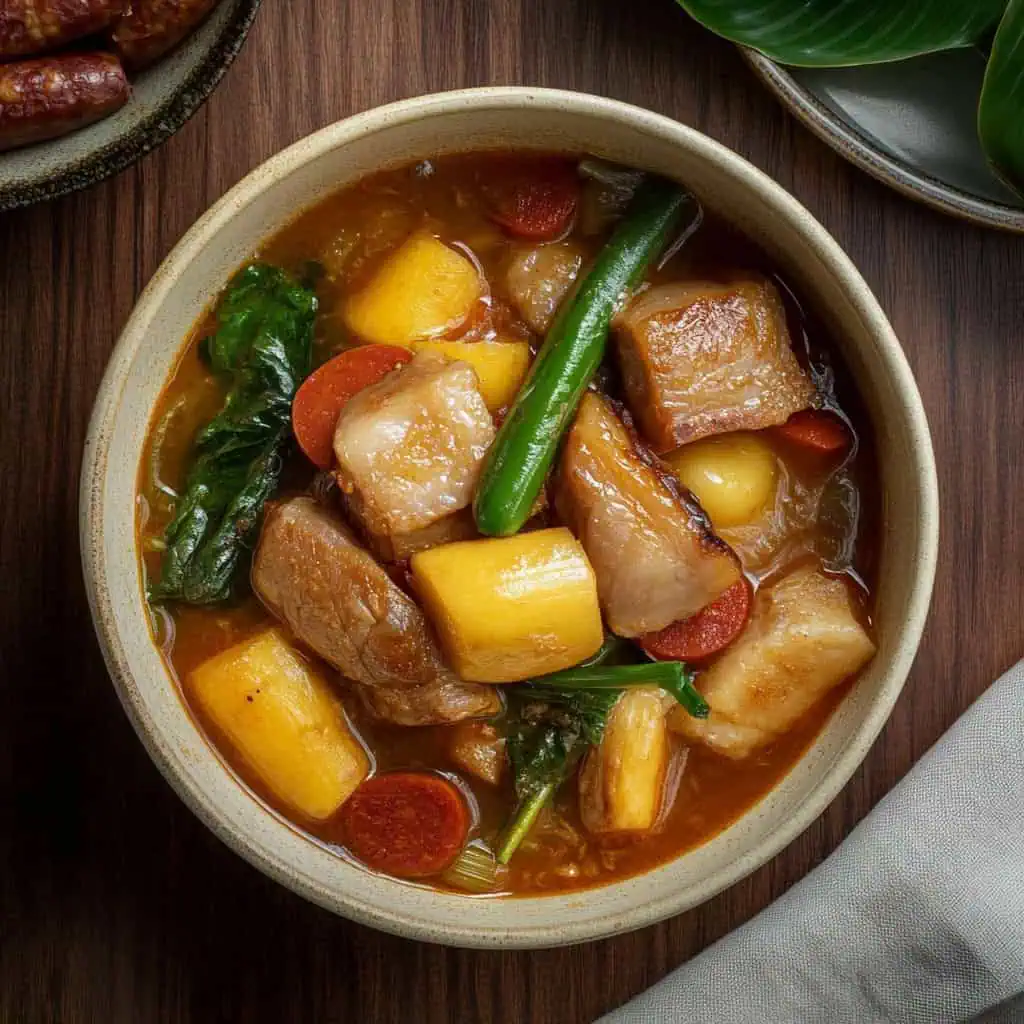
Why You'll Love This Recipe
- Perfect Balance of Flavors: The combination of tender pork, sweet saba bananas, and smoky chorizo creates an unforgettable taste experience
- One-Pot Wonder: Everything cooks in a single pot, making cleanup a breeze
- Make-Ahead Friendly: Tastes even better the next day
- Budget-Friendly: Uses simple ingredients that are easily available
- Customizable: Easy to adapt based on available ingredients
- Family-Sized: Perfect for Sunday family gatherings or batch cooking
Ingredients
The ingredients in this Filipino Pork Pochero work together to create a symphony of flavors and textures. Pork belly provides rich, melt-in-your-mouth tenderness while chorizo adds a smoky depth.
Saba bananas bring a subtle sweetness that balances the savory elements, a signature Filipino touch. The vegetables (potatoes, carrots, pechay, and string beans) add color, nutrition, and substance to the stew.
Pork and beans create a thick, flavorful sauce base while requiring less simmering time than traditional garbanzos. Fish sauce delivers that essential umami punch that ties everything together.
Each component plays a specific role in achieving the perfect balance of flavors that makes pochero a beloved Filipino comfort food.

- 2 pounds pork belly (cut into 2-inch cubes)
- 2 pieces Chorizo de Bilbao (sliced)
- 1 large onion (diced)
- 4 cloves garlic (minced)
- 2 medium tomatoes (chopped)
- 1 tablespoon fish sauce (patis)
- 4 cups water
- 1 can (15 ounces) pork and beans
- 2 ripe but firm saba bananas (cut into chunks)
- 2 medium potatoes (quartered)
- 1 large carrot (cut into chunks)
- 2 bunches pechay (Chinese cabbage)
- 8 pieces Baguio beans (string beans)
- Canola oil for frying
Equipment Needed
- Large Heavy-Bottom Pot (Kaldero) - Provides even heat distribution to prevent scorching and ensures the pork cooks evenly.
- Sharp Chef's Knife - Essential for cutting meat and vegetables uniformly, which helps with even cooking.
- Wooden Spoon - Perfect for stirring without scratching your pot and distributing heat evenly throughout the stew.
- Skimmer - Helps remove any scum that forms during simmering for a clearer, more flavorful broth.
- Measuring Cups and Spoons - Ensures accurate ingredient proportions for balanced flavor.
- Kitchen Thermometer - Takes the guesswork out of knowing when your pork is safely cooked (145°F/63°C).

How To Make
- Prepare all ingredients. Pat dry and cut pork belly into 2-inch cubes. Allow all ingredients to reach room temperature for even cooking.
- Fry key components. Heat oil in your pot to 350°F/175°C. Fry saba bananas until golden (2-3 minutes), then remove. Fry potatoes and carrots until lightly browned (5-6 minutes) and set aside. Finally, fry chorizo until oils release (2-3 minutes).
- Build the base. In the same pot over medium heat, sauté onions and garlic until translucent. Increase to medium-high heat and add pork belly. Brown on all sides until golden (8-10 minutes).
- Create the stew. Add tomatoes and fish sauce. Pour in water and bring to a boil. Reduce heat to low and simmer covered until pork is tender, about 40 minutes. The internal temperature should reach 145°F/63°C.
- Add vegetables in stages. Add pork and beans, potatoes, and carrots. Simmer for 10 minutes. Add Baguio beans and cook for 5 minutes. Finally, add pechay just until wilted (about 2 minutes).
- Finish the dish. Return fried saba bananas and chorizo to the pot. Simmer for 5 more minutes to meld flavors. Let rest for 5 minutes before serving hot with steamed white rice.

Tips from Lola's Kitchen
- Meat selection matters. Choose pork belly with a good meat-to-fat ratio for optimal flavor and tenderness.
- Take time to brown the meat properly. This critical step develops deeper, richer flavors in your pochero.
- Layer your cooking. Add ingredients according to cooking time—root vegetables first, leafy greens last.
- Keep saba bananas firm. Slightly underripe is better than overripe to prevent them from dissolving into the stew.
- Save the chorizo oil. Use the flavorful oil released from cooking chorizo to sauté your vegetables.
- Control your simmer. A gentle simmer (not a rolling boil) keeps meat tender and prevents vegetables from breaking down.
Substitutions
- Pork Belly: Substitute with pork shoulder or chicken thighs if preferred.
- Saba Bananas: Regular plantains work well if saba bananas aren't available.
- Pechay: Bok choy or Napa cabbage make excellent alternatives.
- Chorizo de Bilbao: Spanish chorizo or even bacon can provide similar smoky notes.
- Pork and Beans: Traditional version uses garbanzo beans (chickpeas) with additional tomato sauce.
- Fish Sauce: Soy sauce with a pinch of salt can work in a pinch.
Troubleshooting
- Tough Meat: If your pork isn't tender enough, continue simmering at low heat, checking every 15 minutes. Adding ¼ cup water if needed to prevent drying.
- Watery Sauce: Remove the lid and simmer uncovered for 10-15 minutes to reduce and thicken.
- Overly Soft Vegetables: Add firmer vegetables (potatoes, carrots) earlier and quick-cooking vegetables (pechay) in the final minutes.
- Lacks Flavor: Try adding another tablespoon of fish sauce or a beef bouillon cube to enhance umami.
- Too Salty: Add a quartered potato to absorb excess salt, or dilute with a small amount of water and additional vegetables.
Storage & Reheating
Storage:
- Refrigerator: Store in an airtight container for 3-4 days.
- Freezer: Freeze for up to 3 months (best without leafy vegetables).
- Separation: Store sauce and vegetables separately if possible to prevent vegetables from becoming mushy.
Reheating:
- Stovetop: Reheat slowly over medium-low heat until it reaches 165°F (74°C), stirring occasionally.
- Microwave: Heat in 60-second intervals, stirring between each until thoroughly hot.
- Refresh: Add fresh pechay or herbs when reheating to brighten the dish.
- Revitalize: If sauce has thickened too much, add a small amount of water or broth while reheating.

FAQ
How can I tell if my pork is cooked properly?
The pork should reach an internal temperature of 145°F (63°C) and should be fork-tender, easily pierced with no resistance.
Can I make this in a pressure cooker or Instant Pot?
Yes! Cook the pork for 25 minutes on high pressure with a natural release. Add vegetables afterward and simmer until tender.
What makes pochero different from other Filipino stews like afritada or menudo?
Pochero is distinguished by the addition of saba bananas and the use of pork and beans or chickpeas, creating a unique sweet-savory flavor profile.
How can I make this healthier?
Use leaner cuts like pork loin, increase the vegetable ratio, and reduce oil used for frying components.
Why is my pochero turning out bland?
Make sure to properly brown the meat and develop flavors at each cooking stage. Don't rush the simmering process, as time helps meld the flavors.
Can this be made ahead for special occasions?
Absolutely! Pochero tastes even better the next day as flavors continue to develop. Just reheat gently and add fresh greens before serving.
Related
Looking for other recipes like this? Try these:

Filipino Pork Pochero (Pocherong Baboy)
Equipment
- Large Heavy-Bottom Pot (Kaldero) For even heat distribution and preventing burning
- Sharp Chef's Knife For uniform cutting of meat and vegetables
- Wooden spoon (sandok) For stirring without scratching the pot
- Skimmer (Siyanse) For removing scum during simmering
- Measuring cups and spoons (Panukat) For precise ingredient portions
- Kitchen thermometer To ensure meat is properly cooked (145°F/63°C)
Ingredients
For the Base
- 2 pounds pork belly Liempo, cut into 2-inch cubes
- 2 pieces Chorizo de Bilbao sliced
- 1 large onion Sibuyas, diced
- 4 cloves garlic Bawang, minced
- 2 medium tomatoes Kamatis, chopped
- 1 tablespoon fish sauce Patis
- 4 cups water
- 1 can 15 ounces pork and beans
Vegetables and Fruits
- 2 ripe but firm saba bananas Saging na Saba, cut into chunks
- 2 medium potatoes Patatas, quartered
- 1 large carrot Karot, chunks
- 2 bunches pechay Chinese cabbage
- 8 pieces Baguio beans string beans
- Canola oil for frying
Instructions
- Begin by preparing all ingredients. Pat dry and cut 2 pounds pork belly (liempo) into 2-inch cubes. Ensure all ingredients are at room temperature for even cooking.
- Heat oil in a large heavy-bottomed pot (kaldero) to 350°F/175°C. Pan-fry the saba bananas (saging na saba) until golden brown, about 2-3 minutes. Remove and set aside. In the same oil, fry potatoes (patatas) and carrots until lightly browned, 5-6 minutes. Remove and set aside. Finally, fry the sliced chorizo de bilbao until its oils release, 2-3 minutes.
- Using the same pot over medium heat (350°F/175°C), sauté diced onions (sibuyas) and minced garlic (bawang) until translucent. Increase heat to medium-high (375°F/190°C) and add the pork belly. Brown the meat on all sides until golden brown, about 8-10 minutes.
- Add chopped tomatoes (kamatis) and fish sauce (patis). Pour in 4 cups water and bring to a boil. Reduce heat to low (300°F/150°C) and simmer covered until the pork is tender, about 40 minutes. The internal temperature of the pork should reach 145°F/63°C.
- Add the can of pork and beans, potatoes, and carrots. Simmer for 10 minutes. Add Baguio beans (sitaw) and cook for 5 minutes. Finally, add the pechay and cook just until wilted, about 2 minutes.
- Return the fried saba bananas and chorizo to the pot. Simmer for a final 5 minutes to heat through and allow flavors to meld. Let rest for 5 minutes before serving hot with steamed white rice (kanin).
Tips from Lola's Kitchen
- Use pork belly with a good meat-to-fat ratio for the best flavor
- Never skip browning the meat - it develops deeper flavors
- Add pechay last to maintain its crisp texture
- Keep saba bananas firm to prevent them from dissolving
- Save the chorizo oil for cooking the vegetables
Nutrition
The Story Behind Filipino Pork Pochero
Pork Pochero, or Pocherong Baboy in Filipino, tells a fascinating story of colonial influence and local adaptation in Philippine cuisine. This beloved stew traces its roots to the Spanish cocido, which arrived on Philippine shores during the 333 years of Spanish colonial rule. The name itself comes from the Spanish "puchero," meaning stewpot, reflecting its humble origins as a peasant's one-pot meal.
While the Spanish original relied heavily on chickpeas and cured meats, Filipino cooks transformed the dish by incorporating local ingredients that were abundant in the archipelago. The addition of native saba bananas (plantains) became a distinctly Filipino touch, introducing a subtle sweetness that beautifully complements the savory elements. This adaptation showcases the Filipino talent for adapting foreign dishes while making them uniquely their own.
Today's version often features a modern twist with the use of canned pork and beans instead of traditional garbanzos, a variation that became popular in Filipino households during the American period. This adaptation not only adds convenience but also creates a richer, more flavorful sauce that Filipinos have come to love. The dish remains a Sunday lunch favorite, particularly during the cooler months when families gather around the table to share this heartwarming stew.
What makes Pork Pochero truly special is its ability to reflect the Philippines' complex culinary heritage. The combination of Spanish cooking techniques, native ingredients, and American influences creates a dish that perfectly represents Filipino food culture – adaptive, flavorful, and deeply comforting. Whether served in humble homes or sophisticated restaurants, Pocherong Baboy continues to be a testament to the Filipino people's creativity in the kitchen and their dedication to preserving family food traditions.
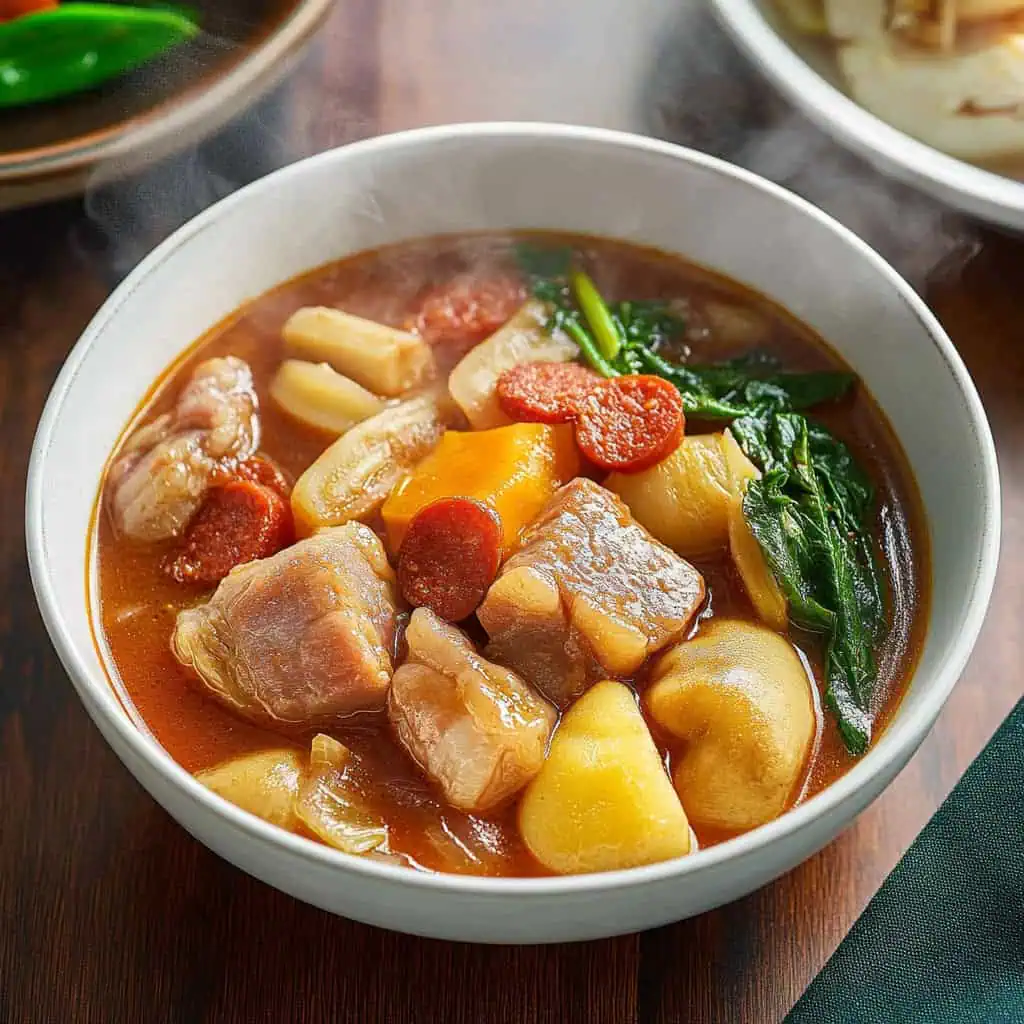

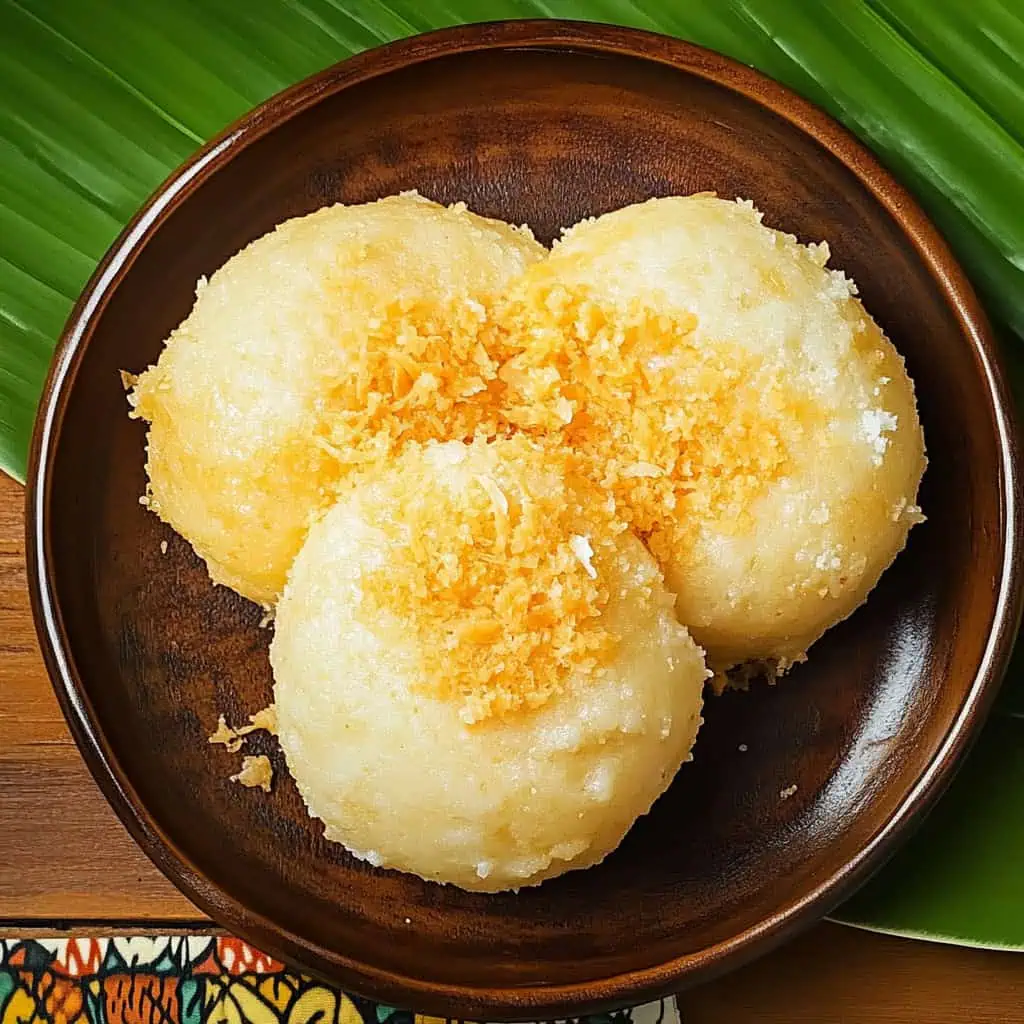
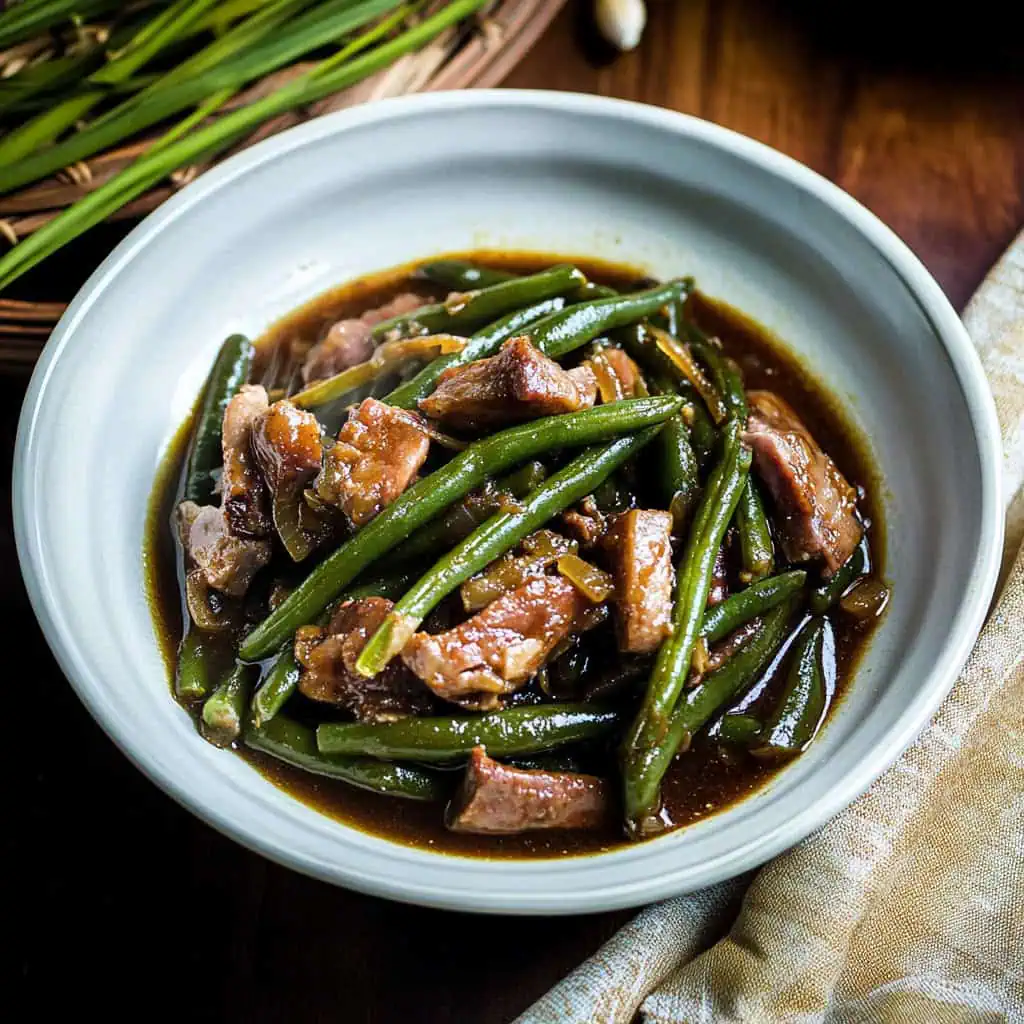

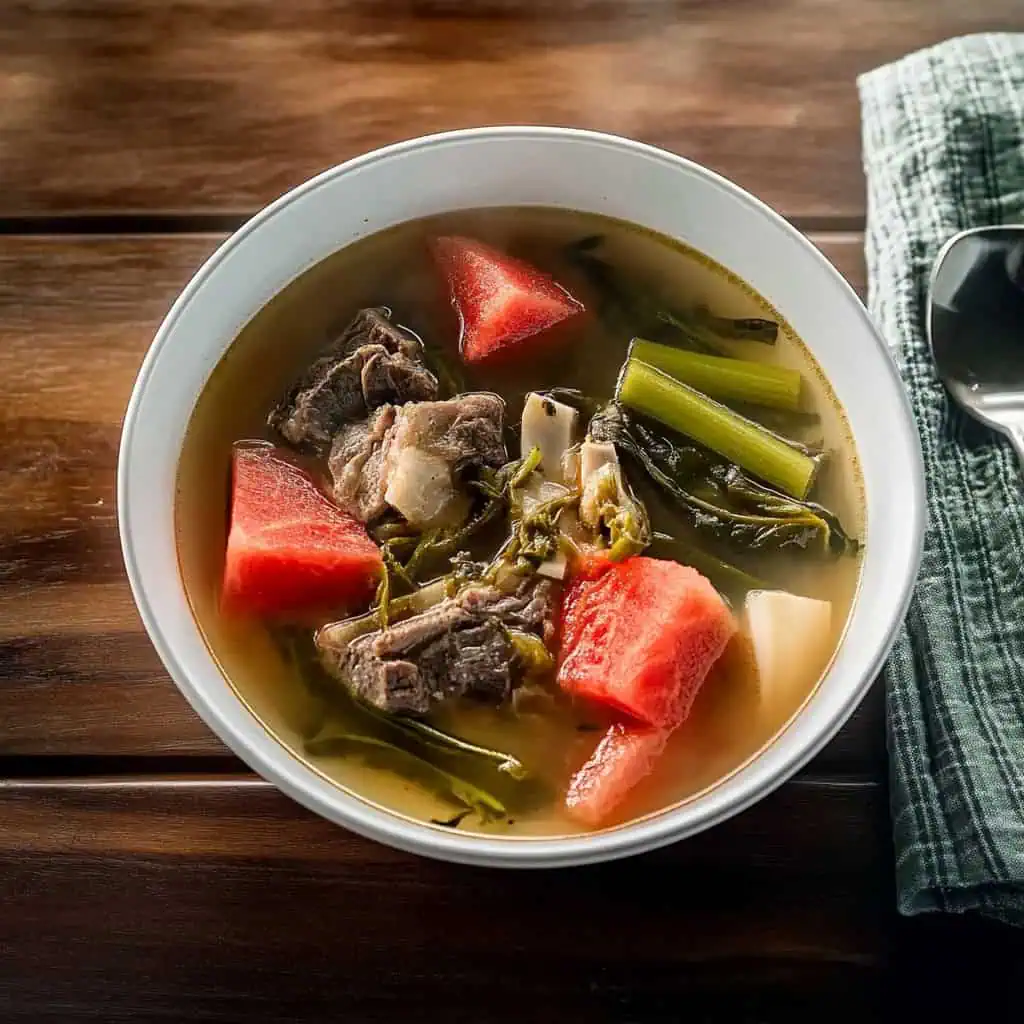




Comments
No Comments